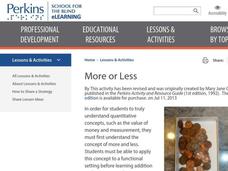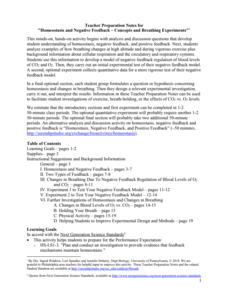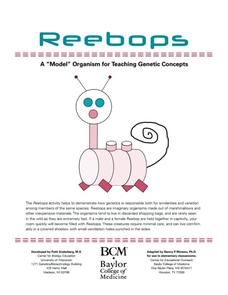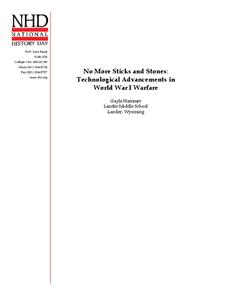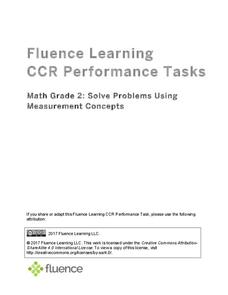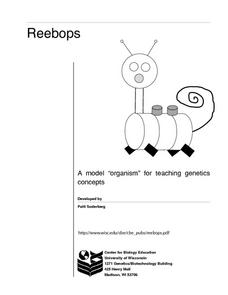Perkins School for the Blind
More or Less
The concept of more or less is one that needs to be mastered prior to learning other concepts such as quantitative analysis, addition, or subtraction. This activity provides several ways to teach learners with low or no vision to...
Curated OER
And 2 More Makes...
If we add two more, how many does it make? Before youngsters start with addition, give them this clearly worded exercise to help them grasp the concept. Kindergartners focus on the term more as they examine...
Melissa Institute for Violence Prevention and Treatment
Concept Muraling
Concept muraling helps learners improve their comprehension of a text by giving them a way to organize their understanding of the key concepts in that text. Introduce readers to this process with a carefully scaffolded instructional...
Curated OER
Time to Draw More or Less Worksheet
Using familiar shapes, learners practice the math concepts more, less, and equal. They examine five circles, drawing two more in an adjacent box. Note: This one should be explained, as learners may not understand they are to...
Curated OER
More or Less
Freddy the Frog helps little learners determine which number comes before and which one comes after. He hops around a number chart and children write down the number one less and one more than where he has landed. This is a very cute way...
Curated OER
And 1 More Makes...
If we add one more, how many will we have? Beginners to addition practice this skill using images and counting as they draw one more sock to each set and record the new total. There are three of these followed by four more similar...
CK-12 Foundation
CK-12 Middle School Math Concepts - Grade 6
Twelve chapters cover a multitude of math concepts found in the Common Core standards for sixth grade. Each title provides a brief explanation of what you will find inside the chapter—concepts from which you can click on and learn more...
Curated OER
Teaching Game Play Concepts
Some children with autism need to be prepped prior to game play, and game play concepts need to be introduced and reinforced. This short yet informative article will help you know how to get the kids in your special ed class ready for...
Mathematics Vision Project
More Functions, More Features
Learners tackle a wide range of intimidating topics in this comprehensive unit that spans piecewise functions, absolute value of functions, and inverse functions (among other topics). Investigative group work alternates with more...
Texas State Energy Conservation Office
Investigation: Concept Mapping Fuels
After reading an article, "Fuels for Everything," collaborative groups create a concept map poster of the transportation and non-transportation fuels. This makes a strong introduction to the different types of fuels used for transportion...
Serendip
Homeostasis and Negative Feedback – Concepts and Breathing Experiments
More asthma attacks happen at higher altitudes, but why? Scholars complete worksheets, learning about homeostasis and feedback related to breathing. Then, they work in small groups to experiment with breathing in limited amounts of...
All Things PLC
Glossary of Key Terms and Concepts
Considering creating a Profession Learning Community at your school? Here's a seven-page glossary of key terms and concepts, everything from action orientation and adaptive to values and vision, that all members should know to...
Curated OER
Make More
In this early childhood concept of more worksheet, students examine 4 groups of items and then draw the number of items listed in order to make more. Students also draw less than 6 spoons.
Curated OER
Some More Please
In this early childhood concept of more worksheet, students examine 4 groups of items and then draw the number of items listed in order to make more.
Biology Junction
Water Properties and More
Did you know many insects use cohesion or surface tension to walk on water? Using a presentation, scholars learn the more important properties of water. It extends into the concepts of solutions, suspensions, pH, and more.
Baylor College
Reebops: A “Model” Organism for Teaching Genetic Concepts
In a sweet simulation, junior geneticists examine the chromosomes of a fictitious Reebop marshmallow animal, combine chromosomes to produce offspring, and then make a model of the resulting Reebop baby. Phenotypes include number of...
National History Day
No More Sticks and Stones: Technological Advancements in World War I Warfare
Remind young historians that many technological advancements influenced the events of World War I. After analyzing technology's evolution through primary sources, discussing the changes over time, and watching various video clips,...
Science 4 Inquiry
Genetics, Genetics, and More Genetics: Exploring Independent Assortment and Non-Mendelian Genetics
Two individuals share 99.9 percent of their genetic codes, yet diversity is observed everywhere. Young scientists learn about diversity through hands-on activities and an experiment. They apply the concepts of independent assortment and...
Curated OER
Pride and Prejudice: Concept/Vocabulary Analysis
Clarify the setting, literary themes, and potential vocabulary issues with a concept analysis resource. With thoughtful explanations of many parts of Jane Austen's Pride and Prejudice, the reference sheet will be a great...
Novelinks
The Giver: Concept Analysis
Cover the vocabulary and thematic concepts from Lois Lowry's The Giver with an extended reference guide. It includes relevant plot elements, discussions on themes and motifs, and any possible issues arising from your class's...
Fluence Learning
Solve Problems Using Measurement Concepts
Young mathematicians demonstrate what they know about measurement with a four-task assessment that focuses on estimation, length, and inches.
Curated OER
Rosencrantz and Guildenstern Are Dead: Concept Analysis
Make sure you are well-informed before embarking on a study of Rosencrantz and Guildenstern Are Dead. This resource includes an analysis of the text that a teacher can use to prepare a unit of study. It covers plot elements, themes,...
Curated OER
More or Less
In this more or less early childhood math learning exercise, students identify the group that has more objects by coloring it.
Curated OER
Reebops a Model "Organism" for Teaching Genetics Concepts
Reebops are cute, marshmallow-based creatures that can be used to teach inheritance. Beginning biologists draw strips of paper that represent chromosomes from two envelopes, one for the father, and one for the mother. Each parent...
